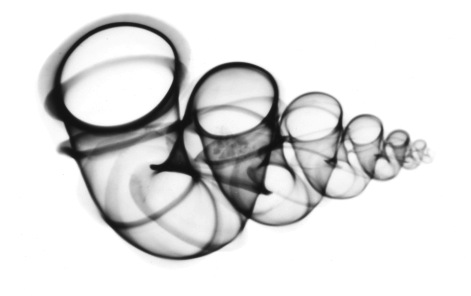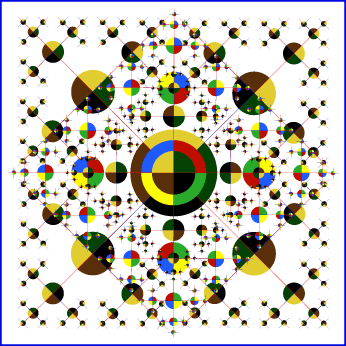
photogerator
to the xth (to the xth/x)
“What is the refrigerator you are a picture of?”
12/17/03: Today I was at an art gallery, where there
are many wonderful photographs. Some of them are big. Not
too many people who I have known own large photographs, but I can
certainly understand why they might, granted sufficient funding.
The power of these images is at once sublime and transmissive. It
seeps in through your eyes and skin, and sets up something of itself
there. It gets into the walls, and the light — even the food
in the distant refrigerator cannot be unchanged in the vicinity
of such a power.
Large prints comprise a huge reflector, and they dominate
cognitive and even emotional terrain with a consistent and perhaps
even haunting regularity of character and presence. These images
are shaping light, and thus connectivity, whenever uncovered. Yet
even when covered, or turned face-to-wall — there is still
something there behind the backing of the frame. I don’t pretend
to desire to name it, but I am clearly aware of it. It’s singularly
and recognizably tangible, but I do not know which sense I sense
it with. I might offer that there’s something about
an image that is a frozen shout, and something in me can hear this
thing. Even if I can’t see the image, I know it’s there,
and because my eye cannot connect with light reflected from it,
does not mean its shout is silenced.
One of the large pieces in the gallery which is not
precisely a photograph is perhaps uniquely worthy of comment: a
charcoal grey expanse upon which loopy ropes of color seem to have
landed and writ their shape. If one did not know what it was they
were looking at — presumably common with this anomalous
abstract — the likely guess would be a painting, accomplished
with some inventive technique. But the image was created by placing
the viscera of a rabbit directly upon the photographic media, whereby
the chemistries in the viscera proceed to interact with the plate
to produce the result — a re-transmitter — of aspects
of that contact-event.
Large in size and vigorous in hues. I could speak at length of the
domains of contact therein recorded, but essentially it is the contact
of life, eyes, light and the valuing of artifacts representing ‘something
which has passed away’. We think of the ‘direction’
of this ‘away’ as being ‘behind us’. This
is a far cry from the reality in my experience.
The rather meandering path I’ve been wandering
along actually leads to a refrigerator, and I should probably
apologize in some way for my preamble, which we can now consider
attended.
In the kitchen at this gallery, they have a black refrigerator,
upon which there are often reproductions of photographs. Apparently
the current set had been there for a long time, and when they were
going to change some of the main images, they took a photograph
of the reproductions of the photographs on the refrigerator.
This was probably done as a playful method of preserving the previous
state. And then they did the thing I liked; they put that photograph
— on the refrigerator.
The novelty of noticing this was pleasing. I thought
(some stuff) but I felt some things that were a lot better
than thinking, before I started thinking about it. In order to talk
cogently about them I have to change time such that 3 seconds becomes
a few minutes.
If I stretch the time ‘before I started thinking’
into a long duration, I can clock the phases a bit and avoid some
of the pitfalls of freeze-framing that get set up once language
and metaphors arrive on the scene — which actually takes a
bit of time...As I translate these feelings into terms I am cognizant
that if I had to do it again I might choose very different words,
and even different feelings. In other words, ‘memories’
about this ‘place before thinking’ tend to change dramatically
with every reference — simply because referencing them semantically,
logically, intellectually, emotionally — parsing them in any
way at all — changes the structure we’re attempting
to ‘photograph’ or freeze such that we can emerge from
ourselves with it in language.
And I need to remark on this, because even though
you’ll think you actually succeeded in reading and understanding
what I am about to say — you won’t be likely to be correct,
because what I am about to say should change the way you understand
what I said — entirely, and it should keep doing that every
time you glance toward it, faster and more complexly than it did
the last time you glanced over there.
When we reach inward — we are seeking to emerge
with a solid statement about or in relation to something we
might call assemblyForms. Inwardly, the movements we must establish
before we begin any dance of expression is one of seeking, and our
decisions about what to seek (and what product we must thus form)
utterly prescribe what we are empowered to encounter and emerge
with. In short, we are too often demanding a photograph of a waterfall,
in a place where we were meant to be playing together in the waters.
And we do get our photograph, indeed. But at what cost and in which
domains of cost?
So in going to get a drink of water, I happened to
turn and face the refrigerator in my return-path. And there I immediately
noticed that something was (strange, different, wrong or needing
notice). There was the sort of ephemeral perception of objects in
space and relation that we are familiar with, but don’t talk
about (for example, it’s always fuzzy in ways we don’t
notice because the parts that are fuzzy can’t be fuzzy if
we noticed the ways they were, or that they were fuzzy at all).
As the general fuzziness (which wasn’t really
visual) began to attenuate toward focus, I realized I was looking
toward a small photograph (not a reproduction) — and then
I noticed it was a photograph of the refrigerator it was on. Immediately
I was struck by a sort of playful wonder, and then a brief moment
of imbalance, as I struggled to assemble metaphors and concretize
what I was perceiving, such that I might then interact with that
concretization. And then I grinned, and I felt this great feeling
of reCognition, which started expanding rapidly — a sort of
fizzy electrical thing, radiating out from somewhere in my belly
perhaps.
Then I began to think.
But I wasn’t thinking about content —
I was thinking about scalarity. I was ‘thinking‘ about
sources of thinking — how self-referencing can ‘invent’
incredible ‘new domains of self-reference’ and complexity-gardening
— while exhibiting another feature we’d have to call
‘a way of going faster, faster than before’.
In our common experience and expression, when we think
of or discuss speed, — we metaphy speed as a kind of reference
to division — distance vs time. This is in part because
we (we are told) exist in 3+1D (three spatial dimensions and one
temporal dimension)...and in part because we must generally agree
with the common models and semantic or logical mores of our living
moment, however poorly they may serve or master us as individuals
and cultures.
There is ‘another kind of speed’, however
— (many kinds, actually) — which the grecian Zeno (of
paradoxical fame) was intimately familiar with. One example of such
a different kind of speed has to do with travel inward — and
is a sort of speed that ‘makes halves of things’ in
a way that includes those making such halves, and time...
Allow me to offer an example...
You take a picture of the pictures (reproductions)
of the pictures on the refrigerator.
Then you put the picture on the refrigerator. Then
you take a picture of the refrigerator which includes this picture
(of the pictures on the ‘fridge).
You place this next to the first one.
But instead of stopping there, you instantly divide
yourself in two, such that there is now self A(1) and self A(2)
— both fully photographically equipped.
Then you simultaneously take a picture of the ‘fridge and of yourself taking this picture, and these go (you
know where).
There are now 4 pictures there, which we should survey
briefly, for they have an interesting quality as individuals —
and is radically magnified in their unity of assembly — in
multiple domains which include the inclusion or outright creation
of new domains:
One of the pictures is ‘of the fridge, and the
pictures that used to be on it’.
The second is an image of the fridge, including that
picture.
The third, includes the first, and second (which includes
the first) — and is still an image of the refrigerator.
The fourth, includes the third, which includes the
second (which includes the first) and first, and it contains
the photographer who imaged the first three states — so a
whole new dimension of participant arises here.
[discus multiple domains of change, and how this is
a step-leap, where we ‘include time’ in a new domain
‘by dividing’.]
Now, (this part is important) half-again faster
than last time, you divide again — and shoot (and place)
the pictures:
A(1) divides into A(1a) and A(1b).
A(2) does similarly...
and we now have 4 photographers (all of whom are you).
This photo-shoot works out thus:
A(2b) shoots
A(2a) shooting
A(1b) shooting
A(1a) shooting the refrigerator with the pictures on it.
Other than A(1a), who is shooting the refrigerator (with pictures),
each otherYou is framing their shot such that they capture both
the refrigerator (and specifically the pictures on it) and the other
shootists ‘before them’ in the order specified above.
Then we add four photographs to the three on the ‘fridge.
4 has become 8, and 5 of these contain photographers, 4 of those
contain photographers shooting other photographers, and I refuse
to abuse you or myself by discussing what is now in the photographs
upon the refrigerator, in terms of which contains how many unique
perspectives of which others. Hopefully, the schema should
be mostly clear from our last survey.

In the next round, however, there will be 8 photographers.
And in the next, sixteen. And each of these rounds will arrive and
pass half-again faster than the last...
Note in the Margins:
Refrigeration slows down time. Time is slower,
when things are cooler. Since time is a biocognitive thing, and
coldness slows down life — coldness slows down time.
Mechanical time is an interesting toy, but time itself
— that’s a living thing — in more ways
than 6....
[I am suggesting that language is a sort of refrigerator
for sentience. In the same way a fridge cools food so that it gains
longevity of function and access, so too does language cool sentience,
logics, and consciousness such that the ‘pictures of the moments
of assembly and relation’ may be preserved, and themselves
‘taken pictures of’ — the result is a rapidly
expanding (in speed, domain, participant, context and relation)
hypersystem. But language in terms of its roots — can ‘go
bad’, just like food. When this happens, a it has on Earth
(in a general and many specific domains) the ‘damage in the
root’ is magnified geometrically out into the branches of
any assembly (tree) we may imagine. The most important thing to
notice about this is that even comparatively minor repairs to metaphoric
damage at ‘the root’ — expand explosively due
to their ‘prevalent inclusion’ in all forms and scales
of more complex assemblies.]
This is what organismal reality is fundamentally about.
hypersystems in recombinant transtemporal relation
[mark of text in process]